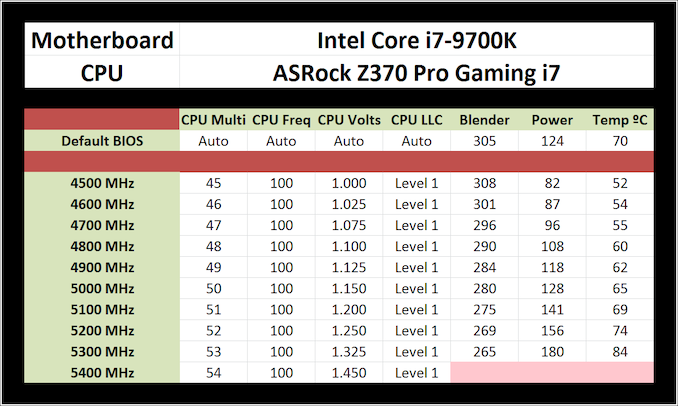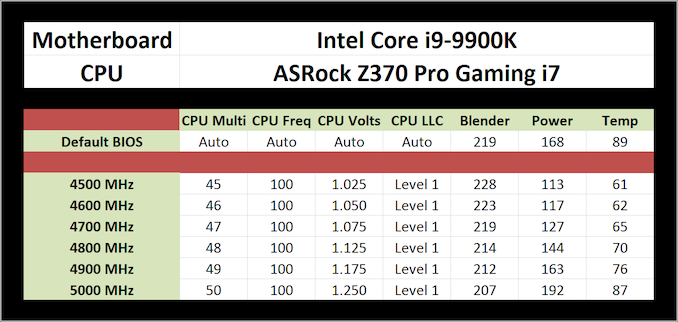The Intel 9th Gen Review: Core i9-9900K, Core i7-9700K and Core i5-9600K Tested
by Ian Cutress on October 19, 2018 9:00 AM EST- Posted in
- CPUs
- Intel
- Coffee Lake
- 14++
- Core 9th Gen
- Core-S
- i9-9900K
- i7-9700K
- i5-9600K
Overclocking
With the upgraded thermal interface between the processor and the heatspreader, from paste to solder, Intel is leaning on the fact that these overclockable processors should be more overclockable than previous generations. We’ve only had time to test the Core i9-9900K and i7-9700K on this, so we took them for a spin.
Our overclocking methodology is simple. We set the Load Line Calibration to static (or level 1 for this ASRock Z370 motherboard), set the frequency to 4.5 GHz, the voltage to 1.000 volts, and run our tests. If successfully stable, we record the power and performance, and then increase the CPU multiplier. If the system fails, we increase the voltage by +0.025 volts. The overclocking ends when the temperatures get too high (85C+).
For our new test suite comes new overclocking features. As mentioned in the previous page, our software loading for power measurement is POV-Ray, which can thrash a processor quite harshly. POV-Ray also does a good job on stability, but is not a substantial enough test – for that we use our Blender workload, which pushes the cores and the memory, and lasts about 5 minutes on an 8 core processor.
Results as follows:
For the Core i7-9700K, we hit 5.3 GHz very easily, for a small bump in power and temperature. For 5.4 GHz, we could boot into the operating system but it was in no way stable – we were ultimately voltage/temperature limited at this case. But an eight core, eight thread 5.3 GHz CPU at 180W for $374? Almost unimaginable a year ago.
Overclocking the Core i9-9900K was not as fruitful. The best bit about this overclock is the 4.7 GHz value: by using our own voltage settings, we reduced power consumption by 41W, almost 25% of the total power, and also reduced temperatures by 24ºC. That's a safe idea. Even 4.8 GHz and 4.9 GHz was reasonable, but the temperatures at 5.0 GHz might not be for everyone. When all cores and threads are loaded, this is one warm chip.












274 Comments
View All Comments
mkaibear - Sunday, October 28, 2018 - link
Yes. Because MSRP is set by the manufacturer and the retail price is set by the retailer. And otherwise they'd have to update the article every single time a price changes.Outlander_04 - Saturday, October 20, 2018 - link
So not value for money, definitely not value for money for gamers, and TWO HUNDRED AND TEN INSANE WATTS OF POWER DRAW.Funniest thing I have heard for a while now
Tkan2155 - Saturday, October 20, 2018 - link
No way im getting this 180 watts. 7nm will help to save energy. Amd need to take down intel. Lets do it together. I cannot stand intel anymore.AutomaticTaco - Saturday, October 20, 2018 - link
Revised power consumption. First motherboard was over-voltage.https://www.anandtech.com/show/13400/intel-9th-gen...
Also, when Overclocked, and set to 1.075v for CPU the consumption actually dropped to 127W max.
https://www.anandtech.com/show/13400/intel-9th-gen...
WannaBeOCer - Saturday, October 20, 2018 - link
Can you post power consumption with MCE Off? The 9900K is a 4.3GHz processor not a 4.7GHz. MCE Auto on Asus boards boost the CPU to 4.7GHz on all 8 cores.mapesdhs - Sunday, October 21, 2018 - link
I remember there was much debate a year or so ago about that, but the whole issue seems to have faded away.Synomenon - Saturday, October 20, 2018 - link
Will the "Thermalright TRUE Spirit 120M BW Rev.A" with push / pull fans be enough to cool the 9900K?http://thermalright.com/product/true-spirit-120m-b...
mapesdhs - Sunday, October 21, 2018 - link
At stock, maybe. Oc'd, almost certainly not.daxpax - Saturday, October 20, 2018 - link
funny there's not 2700x included in benchmarks where AMD has advantage. clearly intel sponsored articlekaosou - Saturday, October 20, 2018 - link
I have a bit of a problem with the price you put on all the charts for ThreadRipper 1920X, at the time the article is posted, you can find TR 1920X at around USD 400, and the USD 799 price you put in the chart is very misleading.